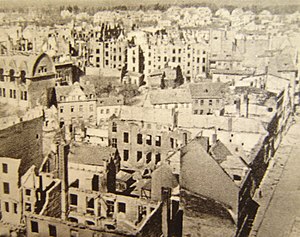Battle of Kolberg (1945)
| Battle of Kolberg | |||||||
|---|---|---|---|---|---|---|---|
| Part of the East Pomeranian Offensive, Eastern Front of World War II | |||||||
 Kołobrzeg (Kolberg) in 1945. 80% of the city was destroyed during the war |
|||||||
|
|||||||
| Belligerents | |||||||
|
|
|
||||||
| Commanders and leaders | |||||||
| Fritz Fullriede | Stanislav Poplavsky | ||||||
| Strength | |||||||
| 10,000 | 28,000+ | ||||||
| Casualties and losses | |||||||
| KIA: unknown ~8,000 captured |
1,206 killed and missing | ||||||
The Battle of Kolberg or Battle of Kołobrzeg (also, battle for Festung Kolberg) was the taking of the city of Kołobrzeg, then the city of Kolberg in German Pomerania by the Soviet Army and its Polish allies from Nazi German forces during the World War II East Pomeranian Offensive. Between March 4 and March 18, 1945, there was major urban fighting of the Soviet and Polish forces against the German army for the control over the city. The Germans succeeded in evacuating much of their military personnel and refugees from the city via sea before it was taken by the Poles on March 18.
In November 1944 Kolberg, a large Baltic seaport in the Province of Pomerania, was designated a stronghold as Festung Kolberg. It was one of the key German positions in the Pomeranian Wall, a vital link between Pomerania and Prussia. The German High Command planned to use the seaport to supply nearby German forces, and hoped that the stronghold would draw off Soviet forces from the main thrust towards Berlin.
The Soviet East Pomeranian Offensive, commencing on February 24, 1945 managed to cut off and surround the city and its defenders (mostly from the German Army Group Vistula). The first commander of Festung Kolberg was an elderly officer, General Paul Hermann, but due to illness he was transferred in February to a less demanding post. The command was taken by Colonel Gerhard Troschel. After March 1 the city was under the command of a former Afrika Korps officer, Colonel Fritz Fullriede.
...
Wikipedia
